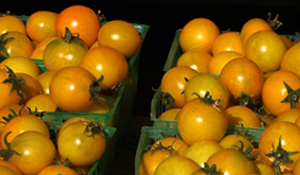BY MELISSA MOSER
A high-energy diet is composed of foods that are produced and processed using a large amount of fossil fuels, which are non-renewable energy sources. Though often inconspicuous to consumers, fossil-fuel energy enters the food production chain through the use of fertilizers and farm equipment, as well as in the processing and transportation of food. Here are some frequently asked questions and answers about the American food system.
How has U.S. farming changed during the last century?
Why do we move food such long distances?
What do pesticides and fertilizers have to do with fossil fuels?
Don’t pesticides and fertilizers help us grow more food?
What does organic mean?
How do I know if a food is organic?
Is organic food really better for my family and me?
Why does organic food cost more?
How do I know if a food is grown locally?
How can I eat locally grown or organic food on a budget?
How do I find local farmers or a farmers market?
Where can I learn to grow my own garden?
What’s the difference between high fructose corn syrup and traditional sugar?
What are people doing to improve the food system and how can I get involved?
How has U.S. farming changed during the last century?
By the middle of the 20th century, farm machinery, pesticides, herbicides, irrigation, new hybrid crops and synthetic fertilizers had allowed for tremendous growth in food production. Essentially, Americans began to use fossil fuel-based inputs as replacements for human and animal labor. This change ushered in an era of inexpensive and abundant food, but harmful consequences of the industrial system began to emerge.
The Post Carbon Institute, a non-profit organization, argues that the large fossil fuel inputs required by the current food system have led to environmental crisis and vulnerability in the face of declining fuel resources. Other critics of the current food system suggest a new arrangement with more farmers, smaller and more diversified farms, less processed and packaged food, and less long-distance hauling of food will be needed to feed the population for the long term. A rapid and smooth transition to a new food system will require governments, communities, businesses and families to work together effectively.
Why do Americans move food over long distances?
Historically, cheap fuel has allowed Americans to transport food at minimum cost, although this practice is changing because of volatile fuel prices. Much of the fresh produce in the U.S. is grown in the Central Valley in California and travels across the country. While specialization is a logical part of the food system – Florida is certainly better suited to grow oranges than Nebraska – it may be worth questioning why New Yorkers should eat greens from California instead of New Jersey.
Consumers have grown accustomed to the easy availability of food that is out of season locally, along with exotic food grown far away. The production of food is a business; suppliers who see an economic opportunity will try to meet consumer demand.
What do pesticides and fertilizers have to do with fossil fuels?
Conventional pesticides and fertilizers are created using fossil fuels, mostly natural gas and oil. Using these chemicals in the production of food degrades natural ecological systems and requires dependence on non-renewable energy sources.
Don’t pesticides and fertilizers help us grow more food?
Yes, they do. But many people question the benefits of the chemicals used by the industrial food system as environmental and health costs increase. A good explanation of issues related to our food system is provided in this paper by the Post Carbon Institute, a non-profit organization.
What does organic mean?
Organic indicates food grown without the use of synthetic chemicals, pesticides or preservatives.
According to the United States Department of Agriculture, products labeled organic must consist of at least 95 percent organically produced ingredients (excluding water and salt). You can learn more about organic certification standards at the USDA Web site.
In some instances, farmers may produce food that meets organic standards, but is not USDA-certified organic because the farmer has chosen, for a variety of reasons, not to participate in the agency’s certification process.
How do I know if a food is organic?
To learn if a food is organic, familiarize yourself with the person or company that grew the food. At farmers markets, you have an opportunity to ask questions of the farmer or farm staff such as: “Do you use any chemical pesticides or fertilizers?” You can ask the market manager (usually found behind an information table) to point out the organic sellers. Farmers are business owners eager to sell their products and are usually happy to answer customers’ questions. Market managers are helpful if you feel uncertain about a grower.
When you’re in the supermarket, pay attention to labeling. Organic foods may bear a USDA Organic label. Produce often has a small sticker with a number on it. If it’s conventional produce, the number on the sticker will usually begin with a four. Organic produce stickers will usually have a number beginning with nine.
Is organic food really better for my family and me?
Nutritional value is based on many things, including the climate, soil, freshness, genetics and farming practices. It may intuitively make sense to avoid eating foods sprayed with chemicals, but scientific studies on this issue are limited. Eating organic food is arguably better for the environment and for farm workers, since it reduces the use of harmful oil-based chemicals. But from a nutrition perspective, eating fresh local food may be a better choice than organic food from far away, as some studies indicate nutritional value is higher when food is eaten soon after being harvested.
Why does organic food cost more?
Without chemicals made from fossil fuels, more labor is required to protect organic crops from insects, diseases and other problems. The production requirements for organics can be more expensive, too. For example, conventional farmers can use sewage sludge and chemical fertilizers on their land, which may be cheaper to buy and transport compared to the compost and animal manure used by organic farmers.
Demand for organic food exceeds the current supply, which also contributes to higher prices. As the number and size of organic producers increases, the price you pay will come closer to that of conventional produce because of increased competition and economies of scale.
How do I know if a food is grown locally?
If you don’t see a sign in the supermarket or a label on the food, ask a store worker or manager. Farmers markets sell locally grown food. Of course, you can’t get any more local than growing your own food or working in a nearby community garden.
How can I eat locally grown or organic food on a budget?
Eating foods that are in season locally keeps the cost down. For example, eating tomatoes in the summer costs less than eating them in the winter. Buying food in bulk when possible also reduces cost. Purchasing a community-supported agriculture box or working in a community garden in exchange for food may also be good options.
How do I find local farmers or a farmers market?
An excellent resource for finding farmers and local food in your area is the Local Harvest Web site. You can also call your local chamber of commerce for this information.
Where can I learn to grow my own garden?
One of the best ways to learn gardening is from an experienced gardener. You could offer your help at a neighbor’s garden in exchange for learning his or her skills. You could also help at a local community garden. See the American Community Gardening Association Web site to identify a community garden near you.
Often, local garden stores and arboretums offer classes, and many books have been written for new gardeners. The Internet also offers many helpful resources such as www.organicgardening.com.
What’s the difference between high fructose corn syrup and traditional sugar?
High-fructose corn syrup is extracted from corn plants that are usually grown using a significant amount of fossil fuel-based fertilizers. Traditional sugar is made from either the sugarcane or sugarbeet plants that do not require such a large amount of fertilizers. HFCS can be cheaper for consumers and producers for a variety of reasons, including government subsidies and tariffs.
What are people doing to improve the food system and how can I get involved?
Vote with your fork! Individuals can bring about change through their collective purchasing power. What kind of food system would you like to see in the U.S.?
Visit the Web sites of the organizations below to learn about their work and volunteer opportunities.
U.S. Working Group on the Food Crisis
Organic Consumers
Food and Agriculture Organization of the United Nations

